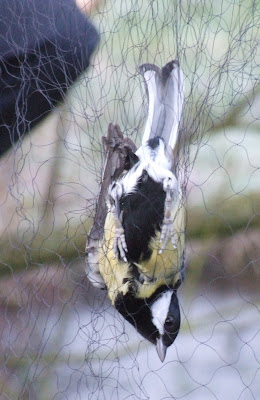Also this year was some survey work for a Scottish National Hertiage (SNH) shorebirds study was also carried out over the first couple of days.
28 Nov
Colin, Brian R, Dave A, Helen and Lorna from ORG and Simon, Kenny and Nigel from HRG travelled out to Sanday and carried out some of the shorebird survey work and also started identifying potential sites for this year's ringing.
29 Nov
I travelled out on the morning boat and met up with the team at the Ayre Rock Hostel which was to be our base for the trip. I went out with Brian R to take a look along the beach to the North of Hine Greenie to see what waders were about. We found a small flock of Sanderling and identified an individual bird that had been colour ringed on a previous visit. On the way back to the car I saw my first Jack Snipe when we flushed it from the grass on the dunes.
In the afternoon I helped out with the shorebird survey covering an area of shore line to the North of Otterswick Bay.
30 Nov
Alison from the North Ronaldsay Bird Observatory (NRBO) arrived on the morning boat to join the team.
With the survey work completed it was time to focus on the ringing. Two catches were made today, both at the Bay of Lopness. The first catch consisted of 2 Purple Sandpipers and 9 Turnstones.
The second catch of consisted of 10 Purple Sandpipers, 5 Turnstones and 2 Sanderling.
One of the Purple Sandpipers was a retrap and was originally ringed on North Ronaldsay in May 2009.
Gavin from the NRBO and Ron and Brian E from the HRG arrived on the evening boat to complete the team.
1 Dec
Another two catches were made today. The first catch was at the Ness of Brough and consisted of 32 Purple Sandpipers and 1 Turnstone. While Ron, Nigel, Gavin and myself processed the catch the rest of the team set off to look for another location to set the nets. While we processing the birds Ron explained to Gavin and myself about using the bill length of the Purple Sandpipers to identify where the birds had originated from. Those with the longer bills had migrated from Canada/Iceland and those with the shorter bills had migrated from Scandinavia. He also talked us through aging the birds explaining that there were thrre different things to look for. These were the colour of the lesser and median coverts, the colour of the tertials and the wear on the tips of the outer primaries.
The second catch was back at the Bay of Lopness and consisted of 3 Purple Sandpipers and 5 Turnstones.
2 Dec
Another two catches were made today. The first catch was at Hine Greenie and consisted of 42 Sanderling and 1 Dunlin.
 |
| Setting the cannon net on the beach at Hine Greenie |
The second catch was at Whitemill Bay and consisted of 7 Purple Sandpipers and 11 Turnstones.
Dave A, Helen, Brian R, Lorna, Alison and Gavin departed on the evening Ferry as they had other commitments on the Monday.
3 Dec
Simon and Kenny departed on the morning boat leaving Ron, Nigel and and Brian E to do some sand sampling at Hine Greenie to try and identify what the Sanderling were feeding on and Colin and myself to drive around the island looking for colour ringed Sanderling.
Unfortunately the weather was against us with strong winds and heavy rain. Colin and myself met up with the sand sampling team and took them back to base to analyse the samples they had recovered from the beach. The analysis revealed that there wasn't much food in the sand which may explain why we weren't seeing large numbers of birds in the usual spots. Why there was a lack of food still needs to be investigated.
Nigel, Colin and myself left Sanday on the evening boat with Ron and Brian following the next morning. All in all it had been a good weekend with some more Sanderling being colour ringed. There should be a couple of follow up visits over the winter to look for colour ringed indiviuals and it will be interesting to see if any are spotted on their breeding ground next spring.
Ringing Summary
The totals caught were:
Dunlin 1
Purple Sandpiper 54
Sanderling 44
Turnstone 31
Totals 130


























